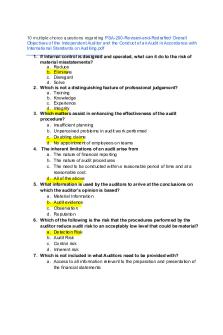Blood - Chapter 10 - Sample Questions PDF

| Title | Blood - Chapter 10 - Sample Questions |
|---|---|
| Course | Biology |
| Institution | Orangeburg–Calhoun Technical College |
| Pages | 3 |
| File Size | 74 KB |
| File Type | |
| Total Downloads | 110 |
| Total Views | 176 |
Summary
Sample questions to practice from the blood chapter....
Description
BLOOD What are the components that make blood? 55% : plasma 45% : erythrocytes (red blood cells) 1% : "buffy coat" leukocytes (white blood cells) and platelets What is hematocrit? measure of total blood volume composed of RBCs What is plasma? transparent liquid composed of : water 90%, plasma proteins, nutrients, antibodies, wastes, minerals, hormones and gases What are erythrocytes? red blood cells whose main function is to attach to hemoglobin to transport oxygen to body cells; anucleate What are leukocytes? white blood cells; function to defend against foreign materials such as bacteria, viruses, etc. What are the two major groups of leukocytes? granulocytes and agranulocytes What are the three types of granulocytes? neutrophils: abundant; kills bacteria and fungus by phagocytosis; first to site infection eosinophils: numbers increase with parasitic worm infections basophils: rarest; contain histamine What are the two types of agranulocytes?
lymphocytes: B and T cells; major role body's immune response monocytes: change into macrophages; fight chronic infections and activate lymphocytes What are platelets? also called thrombocytes; function to aid in blood clotting to prevent hemorrhaging What is anemia? disease caused by inability of blood to carry sufficient oxygen to body cells What is leukopenia? an abnormally low white blood cell count What is leukocytosis? number of white blood cells increases tremendously What are the 3 stages of the blood clotting process? vascular spasm occurs: spasms cause narrow diameter of broken vessel to reduce blood loss platelet plug forms: platelets attract more platelets to form a plug at damaged site to continue to reduce blood loss coagulation event occurs: utilizes clotting factions calcium and potassium in a series of reactions; thrombin acts on fibrinogen to convert it to fibrin; fibrin forms the basis of the clot
What is type A blood? has A antigens on RBCs; anti-B antibodies in plasma; can receive A or O blood What is type B blood? B antigens on RBCs; anti-A antibodies in plasma; can receive B or O blood What is type AB blood? A and B antigens on RBCs; no antibodies in plasma; can receive A, B AB, and O blood; universal recipient
What is type O blood? no antigens on RBCs; anti-A + anti-B antibodies in plasma; can only receive O blood; universal donor What is agglutination? clumping of donated RBCs by recipient's antibodies...
Similar Free PDFs

Chapter 10 Blood
- 2 Pages

PSA200 10 sample questions
- 2 Pages

Chapter 6 Sample Questions
- 2 Pages

Chapter 11 Sample Questions
- 10 Pages

Chapter 16 Sample Questions
- 6 Pages

Sample question The Blood
- 1 Pages

Chapter 23 Sample Questions
- 2 Pages

Chapter 10 Questions
- 2 Pages

Chapter 10 Review Questions
- 3 Pages

Chapter 10 Review Questions
- 4 Pages

Chapter 10 Questions w:soln
- 57 Pages

Chapter 10 Review Questions
- 1 Pages

Chapter 10 practice questions
- 12 Pages
Popular Institutions
- Tinajero National High School - Annex
- Politeknik Caltex Riau
- Yokohama City University
- SGT University
- University of Al-Qadisiyah
- Divine Word College of Vigan
- Techniek College Rotterdam
- Universidade de Santiago
- Universiti Teknologi MARA Cawangan Johor Kampus Pasir Gudang
- Poltekkes Kemenkes Yogyakarta
- Baguio City National High School
- Colegio san marcos
- preparatoria uno
- Centro de Bachillerato Tecnológico Industrial y de Servicios No. 107
- Dalian Maritime University
- Quang Trung Secondary School
- Colegio Tecnológico en Informática
- Corporación Regional de Educación Superior
- Grupo CEDVA
- Dar Al Uloom University
- Centro de Estudios Preuniversitarios de la Universidad Nacional de Ingeniería
- 上智大学
- Aakash International School, Nuna Majara
- San Felipe Neri Catholic School
- Kang Chiao International School - New Taipei City
- Misamis Occidental National High School
- Institución Educativa Escuela Normal Juan Ladrilleros
- Kolehiyo ng Pantukan
- Batanes State College
- Instituto Continental
- Sekolah Menengah Kejuruan Kesehatan Kaltara (Tarakan)
- Colegio de La Inmaculada Concepcion - Cebu


